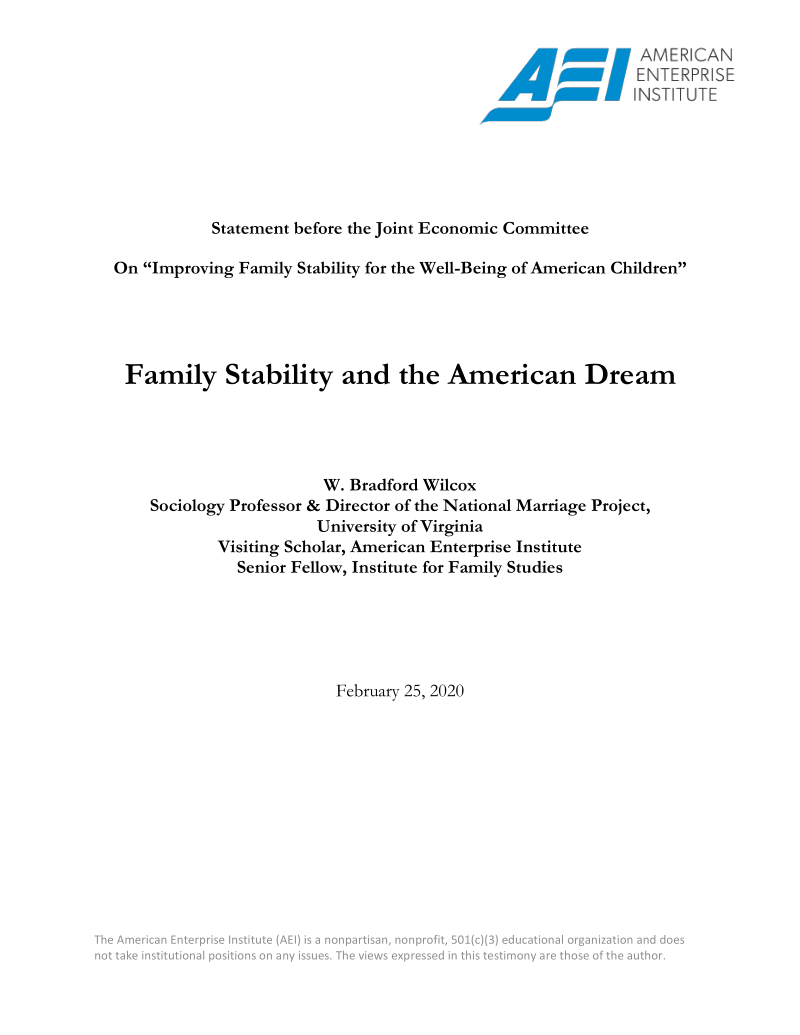Wilcox reviews the social science of marriage and family.
- Type
- Speech / Court Transcript
- Source
- N/A Non-LDS
- Hearsay
- Direct
- Reference
W. Bradford Wilcox, Family Stability and the American Dream, Statement before the Joint Economic Committee On “Improving Family Stability for the Wellbeing of American Children," February 25, 2020, 4-6
- Scribe/Publisher
- American Enterprise Institute
- People
- N/A
- Audience
- Joint Economic Committee On “Improving Family Stability for the Wellbeing of American Children"
- Transcription
The family divide in America matters because the American Dream is in much better shape when stable marriage anchors the lives of children — and the communities they grow up in. My use of the term “marriage” here is deliberate. No family arrangement besides marriage affords children as much stability as does this institution. For instance, children born to cohabiting couples are almost twice as likely to see their parents break up, compared to children born to married couples, even after controlling for confounding sociodemographic factors such as parental education. Figure 4, which displays the likelihood that children will see their parents break up by age 12 for different levels of education and different relationship statuses, is emblematic of the superior stability of married families in America.
[Figure 4]
I cannot here summarize the voluminous literature on family structure and child well-being. But outcomes related to education and economics are suggestive of the ways in which marriage advantages children. When it comes to education, for instance, children raised in stable, married families are more likely to excel in school, generally earning higher grade point averages. The effects of family structure are typically stronger for social and behavioral outcomes related to schooling, such as school suspensions, schools contacting parents about child behavior, and dropping out of high school. Research also indicates that children from married homes are more likely to attend and graduate from college. In other words, children are more likely to acquire the human capital they need to flourish in today’s competitive marketplace when they are raised in stable, married families.
The relationship between family structure and children’s economic well-being is also well established. Because families that have two parents are more likely to have not only a fulltime earner but also two earners, children in stable, married families enjoy markedly higher income and lower risks of poverty and material deprivation. Figure 5 indicates that children living in single-parent homes are at least two times more likely to be in poverty compared to children in married-parent families.
Obviously, much of the association between family structure and child economic well-being is about selection effects: Married parents tend to be better educated and employed in better-paying jobs, even before they marry. However, part of the marriage effect seems to be causal, as well; that is, marriage increases the odds that families have access to two earners, reduces the odds that households go through costly family transitions such as a break up, engenders more support from kin, and fosters habits of financial prudence including more savings. Indeed, research suggests that child poverty would be markedly reduced if the nation enjoyed 1970s marriage levels. Likewise, when it comes to the racial divide in poverty, Penn State University sociologist John Iceland’s work indicates that the effect of family structure is “the most significant factor among blacks — not only for poverty, but also for affluence, explaining about a third of the [racial] disparity in poverty and affluence in 2015.”
[Figure 5]
Family structure also matters for communities. Scholarship by Harvard University economist Raj Chetty and his colleagues indicates that neighborhoods with more two-parent families are significantly more likely to foster economic mobility for poor children. In their words, “the strongest and most robust predictor is the fraction of children with single parents.” They have also found that found that black boys are more likely to achieve upward economic mobility if there are more black fathers in a neighborhood — and more married couples. At the community level, we can see that strong and stable families — including father-present homes — are strongly linked to the health of the American Dream.
Perhaps not coincidentally, neighborhoods, towns, and cities are also safer and less likely to function as pipelines into prison for our young men when they are anchored by strong and stable families. The work of Harvard sociologist Robert Sampson tells us that neighborhoods with many two-parent families are much safer; in his own words, “Family structure is one of the strongest, if not the strongest, predictor[s] of variations in urban violence across cities in the United States.” My own research indicates incarceration rates for boys are markedly lower in neighborhoods with lots of two-parent families. Using Chetty’s publicly available data set, my colleagues and I find that the share of single parents in a neighborhood is one of the most powerful predictors of later incarceration for young men.
In all these ways, and more, the research on family structure and stability tells us that the American Dream is more alive when intact, married families anchor the lives of children.
- Citations in Mormonr Qnas
The B. H. Roberts Foundation is not owned by, operated by, or affiliated with the Church of Jesus Christ of Latter-day Saints.

